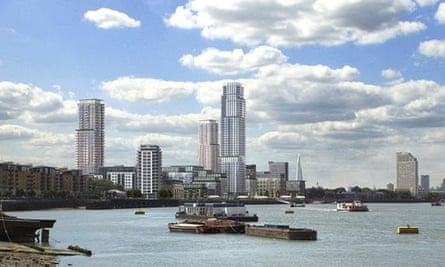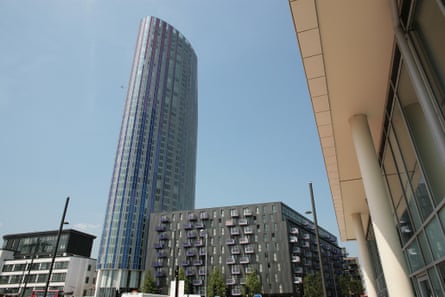Mount Pleasant, a gentle rise between Kings Cross and Farringdon in north London, has always been something of a misnomer. From the 16th to the 19th century, it was home to a stinking heap of rubbish and human excrement. The great dump was finally cleared in 1794 to make way for an imposing brick prison, the notorious Clerkenwell Gaol, where inmates were forced to grind treadmills and pick oakum amid overflowing sewers. It was cleared again in the 1880s for a gargantuan postal sorting office, the largest in the world at the time, which has stood as a majestic shed ever since.
The three-hectare site next to the sorting office is now subject to a planning application for 700 mostly private flats, to be erected in a series of hefty blocks rising up to 15 storeys, which will frame narrow canyons of “public” space in their shadow. Architects should usually be praised for being contextual, but it seems they might have taken the rubbish-dump-prison analogy too far.
“It's like a fortress,” says Edward Denison of the Mount Pleasant Forum, the local residents' association that has been battling this oversized scheme for the past few months. “It's an exclusive development that completely turns its back on the surrounding area, essentially sticking two fingers up at those that live around it. It's the profoundly cynical result of trying to cram as many units on to the site as possible.”
The application, submitted by the recently privatised Royal Mail Group to Islington and Camden councils, whose boundary the site spans, has garnered an increasing amount of hostility, with designer and local resident Thomas Heatherwick now joining the calls to see it halted.
“This proposal is downright lazy – cheap, bland, generic and misconceived,” he wrote to the council this month. “The developer is going to make a vast amount of money from this project, but what is being offered in return is empty, cynical and vacuous.”
The saga took a surprise turn last week when London mayor Boris Johnson weighed into the wrangle and called the scheme in to be determined by his own planning team at the Greater London Authority, taking it out of the local councils' hands – who were set to refuse the application next month. Royal Mail have since slashed their quota of “affordable” housing from 20% to around 12%, though both boroughs have a target of 50%. As a result, this prime plot – the last major housing site left in Islington – will probably offer less than 50 social rented homes, in a scheme that will likely fetch around £4bn in private sales.
“It's outrageous to drop the affordable housing quota as soon as they know it's going out of the local authorities' hands,” says Denison. “But they insist it's the only way to make it 'viable'. If Royal Mail can't make a profit on three hectares of prime real estate in central London, when the land has essentially been given to them by the public for free, something is seriously wrong.”
Both councils have reacted with fury, declaring the mayor's move a circumvention of the planning process and accusing him of making a mockery of local democracy, especially given the scheme had only been submitted in June last year and was due to be determined in the next couple of months.
“London is growing at an unprecedented rate and it is absolutely vital that we get on with the important work of building thousands of new homes as quickly as we can,” responded Johnson, his usual stock rhetoric ignoring precisely what kind of homes are being built in the rush to fulfil his targets. “By taking over this application it should be possible to speed up the decision-making process.” It is an intriguing line of argument, given the last scheme he determined – the 41-storey wedge of Eileen House in Elephant and Castle, granted permission in December – took him more than two years to decide.
While the Mount Pleasant case might be dismissed as the usual cast of nimbys set against the inevitable steamroller of market forces, it in fact reveals some disturbing truths about how the mayor's planning machine is actively working to make the city a more divided, exclusive place.
“It is hardly surprising that the mayor has called this in,” says Duncan Bowie, lecturer in planning at the University of Westminster, who worked in the GLA's planning department under former mayor Ken Livingstone. “The mayoral planning process is based entirely on achieving the maximum number of housing units on any given site, aimed at selling to an international market. The London-wide target of building 42,000 new units per year is predicated on a lot of very high density developments that don't even comply with the mayor's own policies on density.”

Such a development might be found in Convoys Wharf, a £1bn proposal for 3,500 units in the form of three towers rising up to 40 storeys, planned for the historic site of Henry VIII's naval dockyard in Deptford. Johnson called in the scheme in October after the developer, Hutchinson Whampoa, wrote a blustering letter accusing the local authority, Lewisham, of making “unreasonable and unwarranted” demands and pushing the scheme's viability “to its limits”. The move has alarmed local activists, who rightly fear the vast quantity of development is in danger of destroying the area's character. But do such schemes even follow the mayor's own guidance? And does that guidance even matter?
The GLA's Annual Monitoring Report, which measures the implementation of the London Plan – the master document that guides spatial development across the city – reveals that almost two-thirds of all development has breached the mayor's density guidelines. Johnson is setting the rules, only to break them with reckless abandon, rendering his plan utterly meaningless. But the real poison is in his approach to housing.
“Islington and Camden have acute housing need and desperately want lower rented housing on the Mount Pleasant site,” says Bowie. “The question is: should the mayor be using his strategic planning powers to actively prevent councils from providing low-rented housing where there is urgent local need?”
Under Livingstone, there was an ambition – rarely achieved – for 50% affordable housing on new developments (the reality was more like 37%). The idea of a percentage has since been replaced by a numerical target, as has the definition of “affordable”, which now stands at 80% of market rent. Johnson also deleted the idea of social rented housing from the London Plan last year, preventing boroughs from supporting low-rented accommodation – an act for which they are now taking him to judicial review.
“The mayor is driven by entirely the wrong sort of housing targets,” says Michael Edwards, teaching fellow at UCL's Bartlett school of planning. “There is enormous pressure to get the maximum number of units and forget about the affordability. In Mount Pleasant, 'affordable' would be totally out of reach of more than half the population – it makes no contribution to meeting the desperate housing need.”
Obsessed with box-ticking and quota-filling, it is becoming increasingly evident that the mayor's planning team is a dangerous force. They have presided over a wealth of misconceived, mean-minded schemes that are destroying the social and physical fabric of London, lubricating the path for private enclaves of oversized, poorly designed mega-blocks, to be sold to overseas investors with little care for creating decent places to live.

A look further east reveals quite what disastrous results the GLA's eager target-filling frenzy can have, where a gauntlet of teetering towers now stretches down Stratford High Street in a steroidal vision of Dubai-on-Lea. Each dressed in a cheap costume of colourful cladding panels, the towers blare the hollow klaxon of Olympic regeneration, but contain an exclusive world of mostly private one-bed flats behind their gaudy facades and gated podiums.
The GLA planners' reports from the time dutifully note that the schemes far exceed the recommended density for the area, but all this is pardoned for the buildings' “palette of innovative modern materials” and the “active street frontages” – which have remained boarded up ever since.
Similarly, the GLA's initial report on the Mount Pleasant scheme betrays a woeful misunderstanding of the site, ignoring such things as the two adjacent schools and praising part of the site that isn't even within the scheme. A source close to the mayor's planning team reveals that the officers rarely make site visits, instead judging the context from the submitted plans – sometimes aided by a quick look on Google Street View.
“Boris's habit of calling schemes in is setting a worrying precedent,” says the source. “Developers now think they can go straight to the mayor and bypass local planning entirely. The boroughs are scared to dig their heels in, as they know they can be overridden.”
As it stands, the system is not only a benefit for the mayor. By having schemes taken over by Johnson, local councillors can also happily avoid the stigma of being seen to support a scheme that local people are railing against, a particular concern at election time. “The current two-tier planning structure is basically configured to benefit everyone,” adds the source, “except the very residents of London that it should be there for.”







Comments (…)
Sign in or create your Guardian account to join the discussion